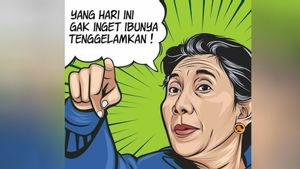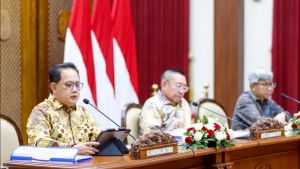JAKARTA - Wayang kulit is a masterpiece belonging to the ancestors of the Bumiputra. Puppets are like a symbol of the progress of civilization. The diversity of types of shadow puppets is proof, from wayang purwa to beber. Stories, language and situations in wayang stories are often considered a source of wisdom across ages. Existed from the time of Hinduism, Buddhism, and Islam. Even wayang is used as a propaganda medium that has a big role in the development of Islam in the archipelago.
No one has been able to explain in detail the exact time when wayang kulit entered the archipelago. Some say wayang kulit has been around since the heyday of Hindu-Buddhist. There are also those who reveal that wayang actually existed long before the arrival of Hindu-Buddhist or the influence of Indian culture.
The speculation was revealed by a Dutch scientist, Jan Laurens Andries Brandes (1857-1905). In his view, wayang was included in the ten elements of the original culture or local genius of the archipelago before the influence of Indian culture.
Wayang then juxtaposed with other local geniuses. Some of them are gamelan, rhythmic poetry, batik, metalworking, currency system itself, shipping technology, astronomy, rice fields, and an orderly government bureaucracy.
This means that wayang has been around for a long time. By Javanese community leaders, shadow puppets were then inserted with Hindu stories. But they did not forget to strengthen the narrative of the story with Javanese characters, ranging from Semar, Bagong, Gareng, Petruk, Bilung and others.
“Evidence has conclusively shown that wayang existed long before the arrival of Islam in Indonesia. The possible form of wayang is in accordance with the model of human depiction on the walls of ancient Javanese temples. In this case, three-dimensional human figures are commonly found in temple wall reliefs, such as the Borobudur Buddhist Monument in the 9th century, and the Hindu Prambanan Temple in the 10th century.”
“These figures closely represent human anatomy. Usually the posture is facing forward, the clothes described are in accordance with the clothes of men and women. We find this model of representation in Central Java during its peak period as a center of political and cultural power. When the center of political and cultural power moved to East Java in the 11th century, there was a change in the depiction of humans from a three-dimensional form to a two-dimensional model," said Sumarsam in the book Meaning of Wayang and Gamelan: Intersection of Javanese, Islamic, and Global Crosses (2018).

The transformation of other shadow puppet forms can be seen from the developing wayang stories. Generally, the popular wayang stories are the Mahabharata and Ramayana stories. The energy of the mastermind who tells the story has a big influence on the story.
A Dutch researcher, J. Kats agrees with that. J. Kats, who had observed 180 Javanese wayang stories in 1923, revealed that nearly 150 wayang stories were stories from the final part of the Pandavas from the Mahabharata Series. The rest are related to the Ramayana, and other stories.
The great skill in managing wayang stories is proof of the vital role of a dalang. He is able to build fantasy in storytelling, insert values to social messages. He can also make human history from century to century is not straight, not singular, and even tends to change. This is the key to the fame of a puppeteer. The story presented is unexpected.
“Javanese wayang performances are an important means of preserving and maintaining the Hindu-Buddhist heritage in Java which has undergone a process of Islamization. The main form of wayang is wayang kulit. The stories in the wayang kulit are based on the Hindu heroic stories, the Ramayana and the Bharatayuddha. The stories of Panji and Damar Wulan, legendary heroes from pre-Islamic times, are also performed in wayang,” wrote MC Ricklefs in the book History of Modern Indonesia 1200-2004 (2005).
Da'wah of Islam through wayang
During the heyday of Islam in the archipelago, the existence of wayang actually increased. The natives at that time did not see Islam as a threat. Mainly adherents of Hinduism, Hindu culture slowly began to be entered by elements of Islam. Precisely Hindus are not happy to play. The tradition began to be adapted by Muslims. Shadow puppets, one of them.
After that, the story of wayang kulit also developed. The story of wayang kulit which was originally dominant in Hindu culture began to be inserted into Islamic literature as inspiration. Cabolek, Centhini, Tajusalatin are some examples. In this series of literature, Islamic elements are seen starting to enter the wayang stories. Most importantly, the process of cultural acculturation provides evidence that the bumiputras have always prioritized religious tolerance.
“The entry of Islam brought by traders from the coast was not initially considered a threat. The high tolerance of the royal elite caused the lower layers to be easily influenced by Islamic teachings. Hindu culture is all incorporated into Islamic elements, and Hindus are happy and even proud that their culture is considered compatible with Islam.”
“For example, the art of shadow puppets began to be inserted with stories about Islam, even then the spreaders of Islam, especially Wali Songo (nine guardians) used wayang kulit as a propaganda display. The terms can also change slowly, for example, the powerful weapon kalimosodo (kalimasada) becomes the sentence of creed, and so on,” explained Putu Setia in the book Bali Inflamed (2008).
It was Sunan Kalijaga from Wali Songo who closely used wayang kulit to spread Islam to all corners of the island of Java. Sunan Kalijaga's great service to Islam is none other than because he made new creations in the wayang kulit stage. The creation was done so that the wayang art matched the tastes of the times. Especially as a propaganda medium. He also tried to incorporate Islamic elements into the wayang.
For example, Sunan Kalijaga made the Pandavas consisting of five truth enforcers as a symbol of the five Pillars of Islam. While Dharmakusuma as the son of Pandu was the first to be given an amulet called "kalimasada" aka the sentence of creed. Even the figure of Bima who always stands tall and strong is symbolized as Prayer. Arjuna who likes to meditate is slowed down as fasting. The last, Nakula and Sahadeva as symbols of zakat and hajj.
"So, Sunan really respects culture. There are no aspects of Islam taught by Sunan without going through culture. The pillars of Islam and faith are introduced using Javanese culture. Wayang kulit is used as a means of preaching.”
“The arts of music (gamelan) and dance are increasingly alive. By respecting this culture, Sunan Kalijaga succeeded in inviting the Javanese to embrace Islam. There is no need for coercion in inviting people to convert. It is enough that the culture itself does the talking. That is the wisdom of Sunan Kalijaga," concluded Achmad Chodjim in the book Sunan Kalijaga: Mystical and Makrifat (2013).
* Read other information about NUSANTARA HISTORY or read other interesting articles from Detha Arya Tifada.
Other MEMORIESThe English, Chinese, Japanese, Arabic, and French versions are automatically generated by the AI. So there may still be inaccuracies in translating, please always see Indonesian as our main language. (system supported by DigitalSiber.id)









